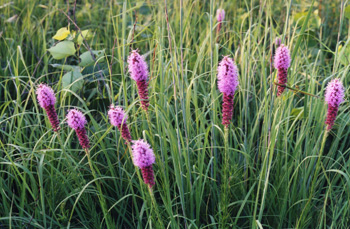Contents:
Common Names | Parts Usually Used | Plant(s) & Culture | Where Found | Medicinal Properties
Legends, Myths and Stories | Uses | Formulas or Dosages | Bibliography
Scientific Names

- Liatris squarrosa L.
- Composite family
Common Names
- Blazing star root
- Rattlesnake-master
- Scaly blazing star
Parts Usually Used
Root
Back to Top
Description of Plant(s) and Culture
Scaly blazing star is a native North American perennial plant; it resembles the marsh blazing star but much smaller, has a tuberous root that produces the stem growing only as high as 2 feet and the leaves to 6 inches long. The alternate linear leaves are dotted, the lower of which are longer. The flower spike is also smaller, made up of blue-purple florets, appears from June to September.
Other varieties: Rough blazing-star
Back to Top
Where Found
Found in dry, open woods, clearings, and fields from Ontario to Pennsylvania and Florida, and westward to South Dakota, Nebraska, and Texas.
Back to Top
Medicinal Properties
Diuretic
Back to Top
Legends, Myths and Stories
Star grass (Aletris farinosa) is sometimes called blazing star.
Back to Top
Uses
Used for gargle of sore throat. Remedy for gonorrhea, snakebite, wounds, insect bites.
Back to Top
Formulas or Dosages
Decoction: boil
Tincture: a dose is
Back to Top
Bibliography
![]() Back to Eden
Back to Eden, by Jethro Kloss; Back to Eden Publishing Co., Loma Linda, CA 92354, Original copyright 1939, revised edition 1994
![]() Eastern/Central Medicinal Plants
Eastern/Central Medicinal Plants, by Steven Foster and James A. Duke., Houghton Mifflin Company, 215 Park Avenue South, New York, NY 10000
![]() The Herb Book
The Herb Book, by John Lust, Bantam Books, 666 Fifth Avenue, New York, NY. copyright 1974.
![]() Indian Herbalogy of North America
Indian Herbalogy of North America, by Alma R. Hutchens, Shambala Publications, Inc., Horticultural Hall, 300 Massachusetts Avenue, Boston, Massachusetts 02115, 1973
![]() Indian Uses of Native Plants
Indian Uses of Native Plants, by Edith Van Allen Murphey, Meyerbooks, publisher, PO Box 427, Glenwood, Illinois 60425, copyright 1958, print 1990
 How Indians Use Wild Plants for Food, Medicine & Crafts
How Indians Use Wild Plants for Food, Medicine & Crafts, by Frances Densmore, Dover Publications, Inc., 180 Varick Street, New York, NY 10014, first printed by the United States Government Printing Office, Washington, in 1928, this Dover edition 1974
![]() Webster’s New World Dictionary
Webster’s New World Dictionary, Third College Edition, Victoria Neufeldt, Editor in Chief, New World Dictionaries: A Division of Simon & Schuster, Inc., 15 Columbus Circle, New York, NY 10023
![]() Indian Uses of Native Plants
Indian Uses of Native Plants, by Edith Van Allen Murphey, Meyerbooks, publisher, PO Box 427, Glenwood, Illinois 60425, copyright 1958, print 1990
